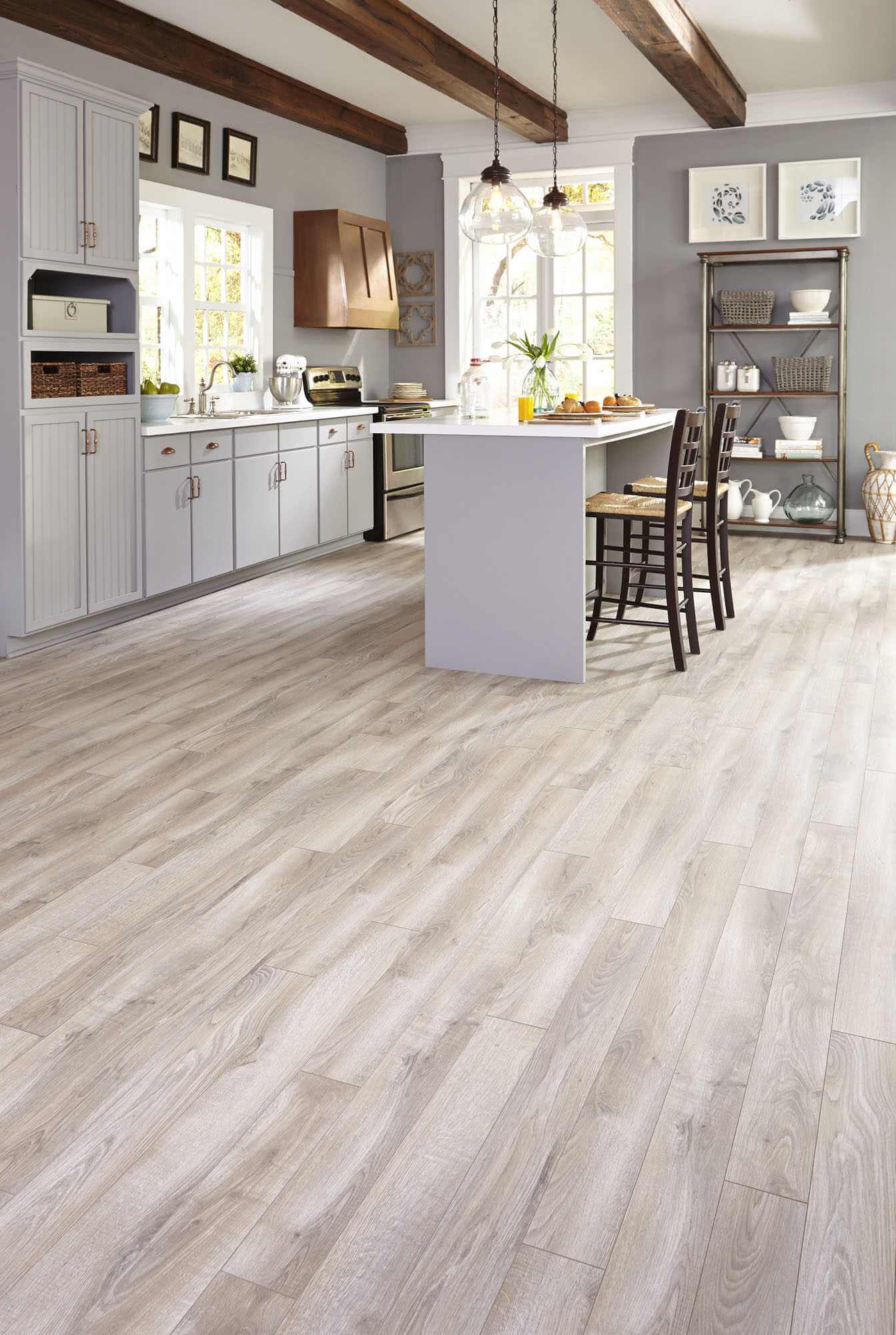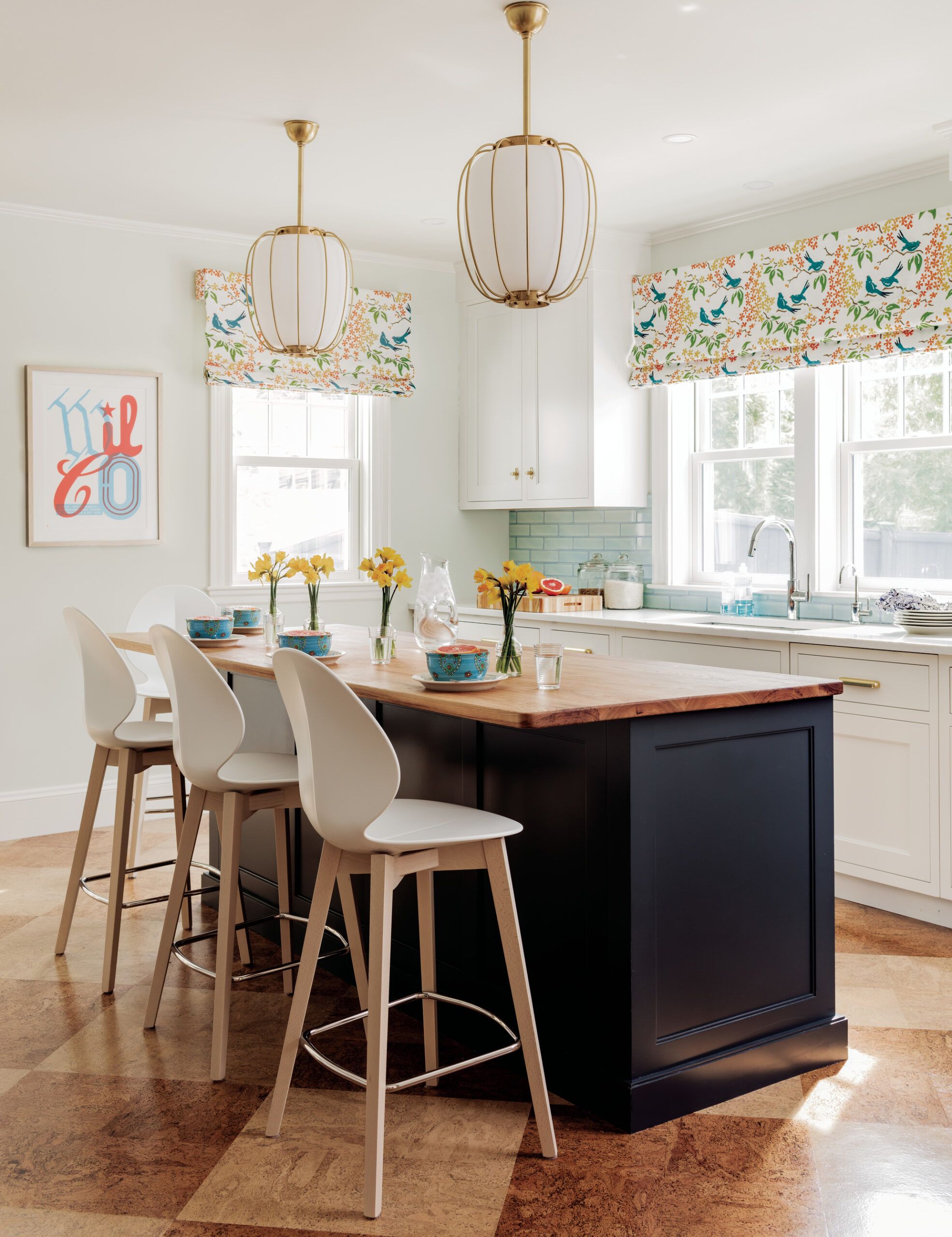Cork Flooring: Why It’s Perfect for Kitchens
When choosing flooring for your kitchen, you want something that combines durability, comfort, and aesthetic appeal. Cork flooring is an often-overlooked option that excels in all these areas. Here’s why cork flooring is perfect for kitchens.
- Comfort Underfoot: One of the most appealing features of cork flooring is its comfort. The natural composition of cork, which includes millions of tiny air pockets, gives it a cushioned feel. This makes it a pleasure to stand on for extended periods, which is particularly beneficial in a kitchen where you might be cooking or washing dishes for a long time.
- Natural Insulation: Cork is a natural insulator, meaning it maintains a comfortable temperature underfoot. Unlike tiles or hardwood, which can feel cold in the winter, cork stays warm, making your kitchen a cozier place. This thermal insulation also contributes to energy savings, as it helps maintain a stable temperature in the room.
- Sound Absorption: Kitchens can be noisy places, with the clattering of dishes, the hum of appliances, and the chatter of family members. Cork’s natural properties make it excellent at absorbing sound, and reducing noise levels in your kitchen. This makes it an ideal choice for open-plan homes where the kitchen is a central hub of activity.
- Eco-Friendly Option: Cork is a renewable resource harvested from the bark of cork oak trees, which regenerate their bark every few years. This makes cork flooring an eco-friendly choice compared to other flooring options that may require the harvesting of entire trees or non-renewable materials. Choosing cork contributes to sustainable living and supports environmentally friendly practices.
- Resilient and Durable: Cork flooring is naturally resistant to impacts, making it less likely to show dents from dropped pots and pans. It also has a natural resistance to moisture and mold, which is crucial in a kitchen environment. While it requires some care, cork can last for decades with proper maintenance, providing excellent value for money.
- Aesthetic Appeal: Cork flooring comes in various colors and patterns, allowing you to find an option that complements your kitchen’s design. Whether you prefer a natural look or something more contemporary, cork can be adapted to suit your style. Its unique texture and warm tones can add a touch of elegance and sophistication to any kitchen.

Benefits of Cork Floor Tiles
Choosing flooring for your kitchen involves balancing practicality with sustainability. Cork floor tiles offer both, providing a durable, eco-friendly option that doesn’t compromise on style. Here are the key benefits of cork floor tiles.
Renewable Resource: Cork is harvested from the bark of cork oak trees, which regenerate every nine years. This makes it a highly sustainable material, unlike other flooring options that may involve deforestation or depletion of non-renewable resources. By choosing cork tiles, you’re supporting a renewable resource and promoting sustainable forestry practices.
Comfort and Safety: Cork tiles provide a soft, cushioned surface, making them more comfortable to stand on for long periods compared to harder flooring options like ceramic or stone tiles. This can reduce fatigue and strain, which is especially beneficial in a kitchen where you might spend hours preparing meals. Additionally, the softer surface of the cork is less likely to cause injury if someone falls.
Insulation Properties: Cork is a natural insulator, offering excellent thermal and acoustic insulation. This means it helps keep your kitchen warm in the winter and cool in the summer, contributing to energy efficiency. It also reduces noise levels, making your kitchen a quieter, more pleasant place to work and gather.
Hypoallergenic and Healthy: Cork has natural properties that resist mold, mildew, and insects, making it a healthier choice for your home. It doesn’t off-gas or release harmful chemicals, contributing to better indoor air quality. For those with allergies or respiratory issues, cork’s hypoallergenic properties can make a significant difference.
Durability and Easy Maintenance: Cork floor tiles are known for their resilience. They can withstand heavy foot traffic and are resistant to scratches and dents. Regular sweeping and occasional mopping are typically all that’s needed to keep cork tiles looking their best. Additionally, cork can be refinished if it begins to show signs of wear, extending its lifespan even further.
Aesthetic Versatility: Cork tiles come in a range of colors and patterns, allowing you to create a unique look for your kitchen. Whether you prefer a traditional appearance or a more modern design, cork can accommodate your aesthetic preferences. Its natural texture and warm hues can enhance the beauty of your kitchen, making it a welcoming space.
Enhancing Your Kitchen Aesthetics with Cork
Cork flooring is not only practical but also offers a wide range of design possibilities. Its unique appearance and adaptability can transform your kitchen into a stylish and comfortable space. Here’s how cork can enhance your kitchen aesthetics.
Natural Beauty: Cork flooring brings a natural, earthy feel to your kitchen. Its unique grain patterns and warm, rich colors can create a welcoming and cozy atmosphere. Each piece of cork flooring is distinct, adding character and a sense of individuality to your kitchen design.
Variety of Styles: Cork flooring is available in a variety of styles, colors, and patterns. You can choose from traditional cork tiles that highlight the material’s natural texture or opt for planks that mimic the look of hardwood or stone. This versatility allows you to match your flooring to any kitchen decor, whether it’s rustic, modern, or eclectic.
Customizable Patterns: With cork tiles, you can create custom patterns and designs to make your kitchen truly unique. From classic herringbone to contemporary geometric patterns, cork tiles can be arranged in numerous ways to suit your style. This customization extends to mixing and matching different shades and textures of cork for a distinctive look.
Complementary to Various Colors: Cork’s neutral tones make it easy to coordinate with different color schemes and kitchen elements. Whether your kitchen features bold, vibrant colors or a more subdued palette, cork flooring can complement your design. Its warm hues can enhance the look of wooden cabinets, stainless steel appliances, and colorful backsplashes.
Seamless Integration: Cork flooring can seamlessly blend with other types of flooring in your home. If your kitchen opens up to a living or dining area, cork can provide a smooth transition between spaces. Its versatile look can unify different areas of your home, creating a cohesive and harmonious environment.
Eco-Chic Appeal: Using cork flooring is not only a design choice but also an eco-friendly one. Its sustainability and natural origins appeal to environmentally conscious homeowners. Incorporating cork into your kitchen design can reflect your commitment to sustainable living while adding a touch of modern, eco-chic style to your home.
Practical Considerations for Kitchen Flooring
When selecting kitchen flooring, durability and ease of maintenance are crucial factors. Cork flooring excels in both areas, making it a practical choice for busy kitchens. Here’s what you need to know about the durability and maintenance of cork flooring.
Resilience and Flexibility: Cork flooring is known for its resilience and flexibility. It can withstand heavy foot traffic, which is common in busy kitchens. The natural elasticity of cork allows it to recover quickly from impacts, making it resistant to dents and scratches. This resilience helps cork flooring maintain its appearance even in high-traffic areas.
Water Resistance: While cork is naturally water-resistant, it’s important to note that it’s not entirely waterproof. Proper sealing and regular maintenance can enhance its water resistance, making it suitable for kitchen environments where spills are common. Ensuring that cork flooring is properly sealed will prevent water from seeping into the material and causing damage.
Easy to Clean: Cork flooring is easy to clean and maintain. Regular sweeping or vacuuming to remove dirt and debris, along with occasional damp mopping, is typically all that’s needed to keep cork floors looking their best. Using a pH-balanced cleaner specifically designed for cork can help maintain its finish and prolong its lifespan.
Stain Resistance: Cork flooring is resistant to stains, thanks to its natural properties and the sealants used to protect it. However, it’s still important to clean up spills promptly to prevent potential staining. Sealed cork floors are less likely to absorb liquids, making them easier to clean and maintain.
Refinishing Options: One of the advantages of cork flooring is that it can be refinished if it begins to show signs of wear. Sanding down the surface and applying a new layer of sealant can restore the floor’s appearance and extend its lifespan. This makes cork a cost-effective option, as refinishing is often less expensive than replacing the flooring entirely.
Preventive Care: To maintain the durability and appearance of cork flooring, it’s essential to take preventive measures. Using protective pads under furniture, placing doormats at entrances to reduce dirt and debris, and avoiding high-heeled shoes on the floor can all help protect the surface. Regular maintenance and preventive care will ensure that your cork flooring remains beautiful and functional for years to come.
Installation Tips and Considerations
Installing cork flooring in your kitchen requires careful planning and attention to detail. By following some essential tips and considerations, you can ensure a successful installation and enjoy the benefits of cork flooring for years to come.
Preparation and Planning: Before installation, it’s crucial to properly prepare the subfloor. The surface should be clean, dry, and level to ensure the cork tiles or planks adhere correctly. Measure the kitchen area accurately and plan the layout, considering the direction of the tiles or planks for the best visual effect.
Acclimation: Cork flooring needs to acclimate to the room’s temperature and humidity before installation. Lay out the cork tiles or planks in the kitchen for at least 48 hours before installation. This helps prevent expansion or contraction after the flooring is installed, ensuring a stable and long-lasting finish.
Adhesive and Underlayment: Choosing the right adhesive is essential for a successful cork flooring installation. Use a high-quality adhesive recommended by the manufacturer to ensure a strong bond. Additionally, consider using an underlayment to provide extra cushioning and sound insulation. The underlayment can also help with moisture resistance, an important factor in kitchens.
Installation Process: Follow the manufacturer’s instructions carefully during the installation process. Start from the center of the room and work your way outwards, ensuring that the tiles or planks are aligned properly. Use spacers to maintain consistent gaps between the tiles or planks, which will be filled with sealant later. Press down firmly on each piece to ensure a secure fit.
Sealing and Finishing: Once the cork flooring is installed, apply a high-quality sealant to protect the surface. This step is crucial for kitchens, where spills and moisture are common. The sealant will enhance the water resistance of the cork and protect it from stains and scratches. Allow the sealant to dry completely before using the kitchen.
Post-Installation Care: After installation, avoid placing heavy furniture on the cork flooring for at least 24 hours to allow the adhesive and sealant to set properly. Regular maintenance, including sweeping, vacuuming, and damp mopping, will keep the cork flooring in top condition. Address any spills immediately and reseal the flooring periodically to maintain its protective layer.
Related Posts:



